People
‘I Love Thinking of Land as a Living Thing’: Artist Teresita Fernández on Working With Nature as Material
The artist's work will be in dialogue with land works by Robert Smithson at SITE Santa Fe this summer.
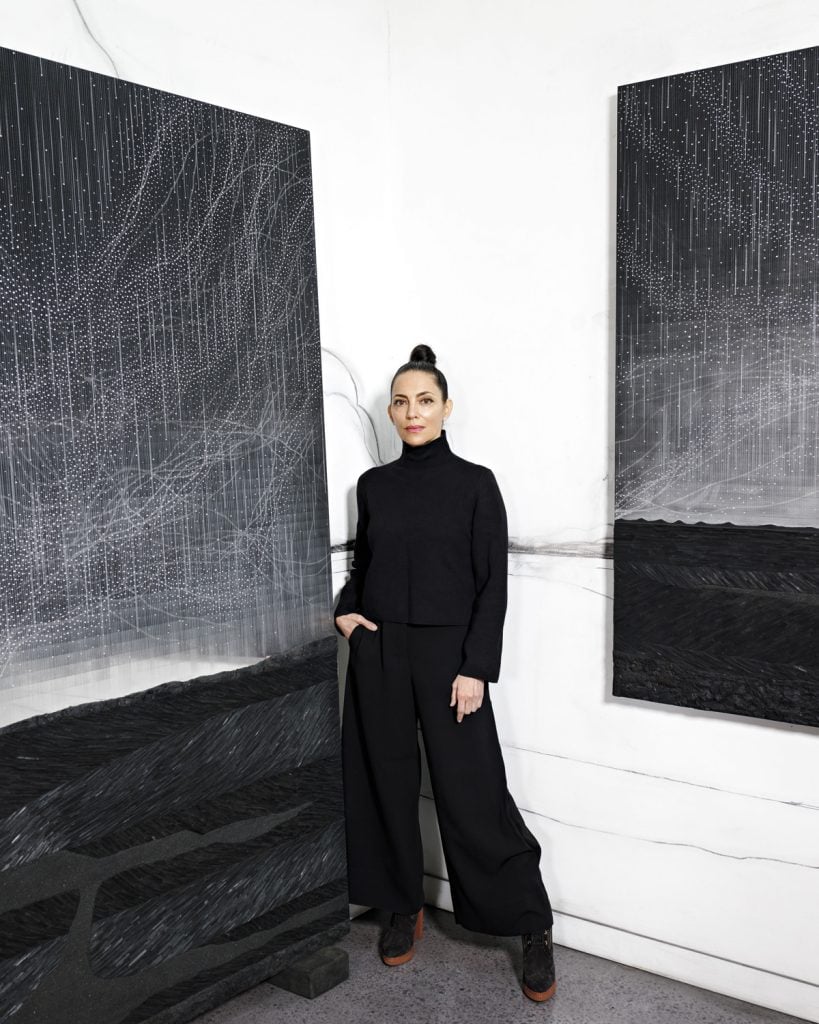
The artist's work will be in dialogue with land works by Robert Smithson at SITE Santa Fe this summer.

Devorah Lauter

Throughout life, we’re encouraged to ask who we are. But what if the answer has a lot to do with where we are?
That is a question the Miami-born artist Teresita Fernández has spent three decades exploring through her sculptural practice with earthen materials. Ranging from massive public installations to delicate, intimately scaled pieces, Fernández’s work engages with landscapes of all kinds—from globally charged socio-political climates to our psychic inner worlds.
Running through her work—for which she was awarded a MacArthur Foundation “Genius Grant” in 2005—there is “this idea about understanding who we are through a kind of peeling back of the layers of where we are,” the New York-based artist told me during a recent Zoom interview. “Because if you do that, then you can figure out who you are in relation to one another as well.”
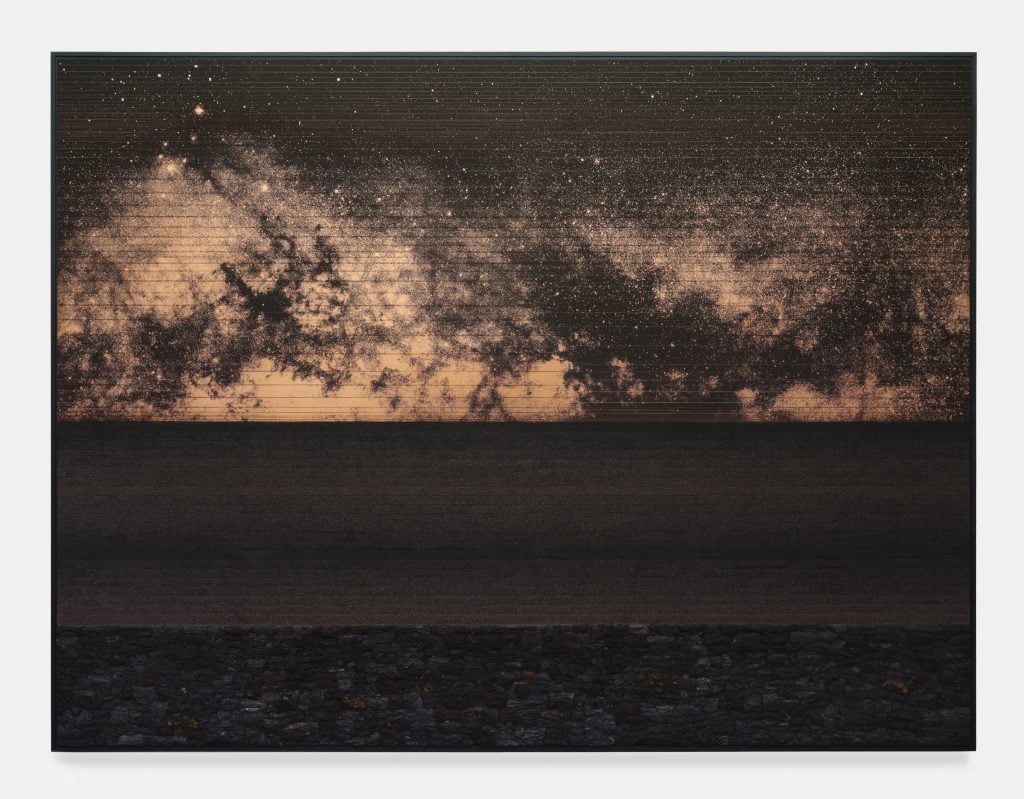
Teresita Fernández, Soil Horizon 1 (2024). Courtesy the artist and Lehmann Maupin, New York, Seoul, and London.
Fernández’s latest solo exhibition “Soil Horizon” is now on view at Lehmann Maupin in New York, featuring rich “land portraits” on copper relief panels and the artist’s first film. The panel series shows layers of earth stacked in warm tonal gradations beneath an airy cosmos, which meet at a horizon line that splits the field of view. Ground and sky seem to feed one another in these abstracted images that don’t share the legible political messages of some of the artist’s past works, like the reconfigured charcoal maps that challenge colonial narratives.
Rather, Fernández offers what she calls a “personal and political” reflection on grief, and the cycle of life and death, with works like Sky (Burial), made of 7,500 glazed ceramic cubes, and a 24-foot-long floor sculpture in cast concrete, Sunrise (Sunset), an evocation of ancient burial mounds, though it can be interpreted freely. She notes it “almost looks like a planet or a sphere rising from the ground.” But within these somber perspectives, there is also beauty and the promise of life coming from the earth.
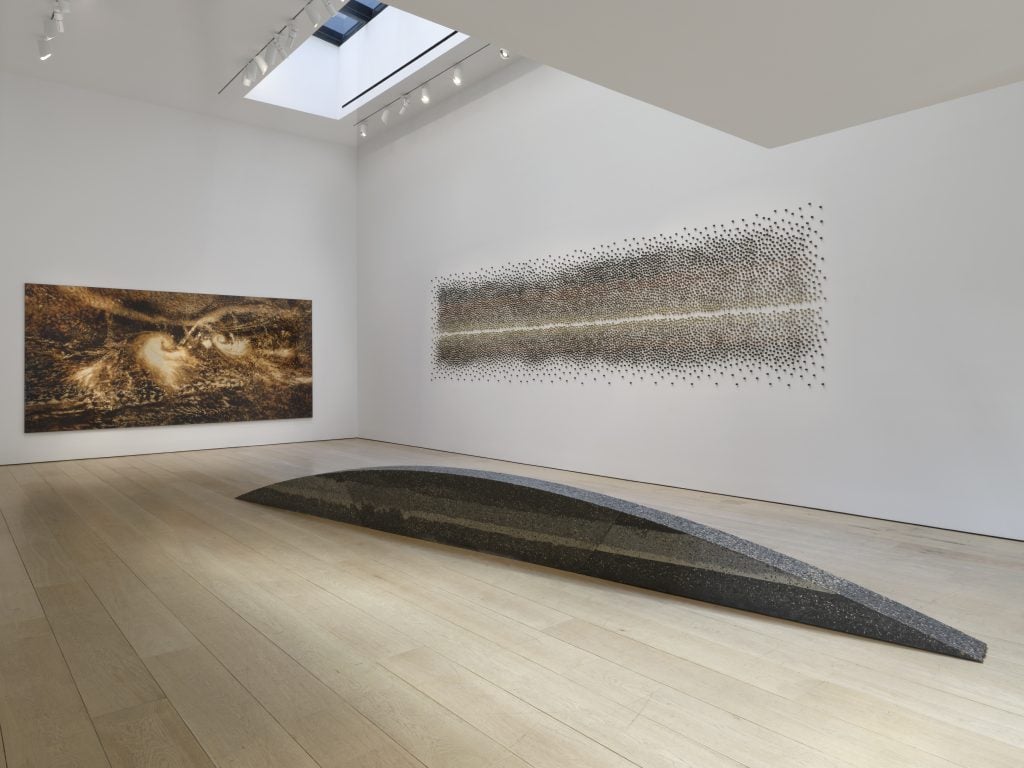
Installation view of “Teresita Fernández: Soil Horizon” at Lehmann Maupin in New York. Courtesy the artist and Lehmann Maupin, New York, Seoul, and London.
“I love thinking of land and place as a living thing, rather than as a stage set for humans, or a kind of object,” Fernández said, referring to landscapes that “also live inside of us,” as spaces we create in our imaginations. This idea is a “very commonly accepted way of seeing oneself in the world” for Japanese, Chinese, Native American, African, and Afro-Cuban cultures alike, she added. “I’ve always been interested in this deep and radical teasing out of what we mean when we say ‘land,’ or ‘landscape,’ or ‘place,’ and how that often gets divorced from our being in that place or what has happened in that place.”
It is an exercise Fernández is undertaking in a forthcoming project this summer for SITE Santa Fe, when she will be the first contemporary artist to show her work in conversation with the deceased land artist Robert Smithson. The dual exhibition promises a constructive, critical reading of both their practices, and of the heroic stereotypes around land art more widely. Lisa Le Feuvre, the show’s co-curator and the executive director of the Holt/Smithson Foundation, said the organization does not shy away from “the problems with Robert Smithson,” and that “there is no artist other than Teresita that we wanted to do this with.”
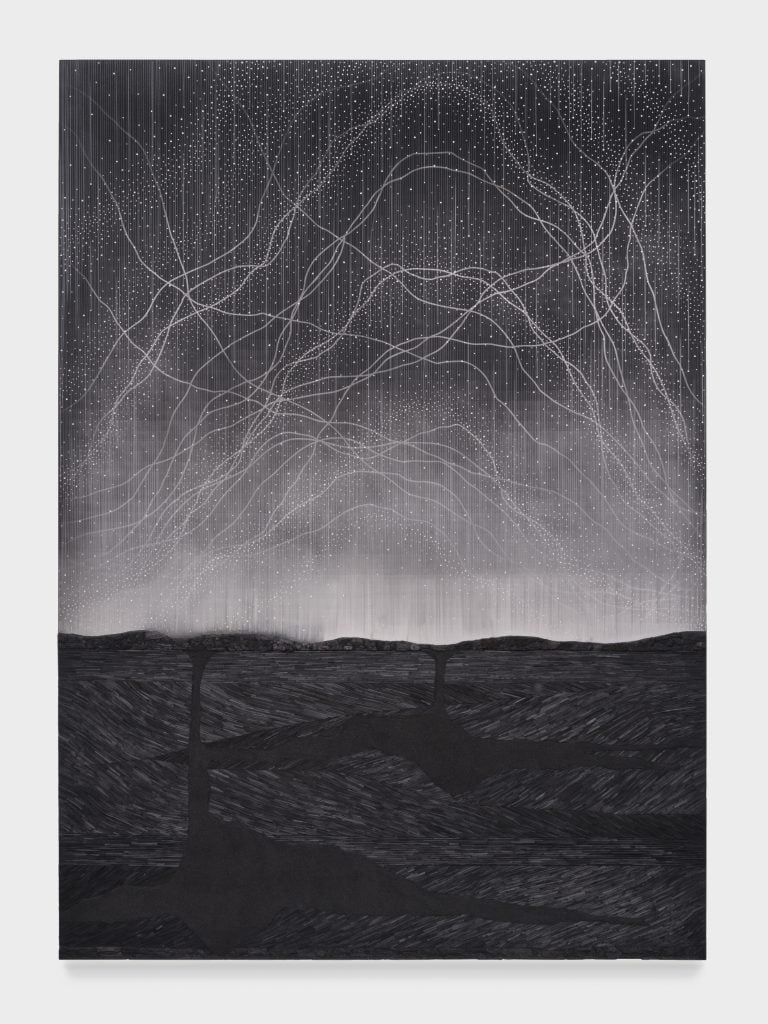
Teresita Fernández, Dark Earth(Woven Sky) (2023). Courtesy the artist and Lehmann Maupin, New York, Seoul, and London.
Can Fernández’s own work be understood as “land art”? It’s a loaded term, and one whose limitations she’s currently probing. She described the Santa Fe exhibition as “an unraveling of a conversation that I feel has been missing from my own education,” taking aim at the “ridiculous notion” that land art emerged with Smithson and his peers in late 1960s and ’70s America. “The way in which that term is tied to a particular, very recent moment in time, but refers to something that is as old as human beings themselves, is highly problematic. It’s indicative of the kind of bubble that the art world somehow feels very comfortable in.”
The time may be right to burst it—albeit relatively gently. Le Feuvre said Fernández had a “quiet politics” that invited discussion, rather than shutting down divergent viewpoints. “She’s saying, ‘Let’s think together about how difficult everything is, and maybe by doing that we can make a difference,’” Le Feuvre said. “She seduces you with the beauty of the work, but once she’s drawn you in, you realize you’re not dealing with a simple, pretty picture. You’re dealing with something that is so researched and so important for the present.”
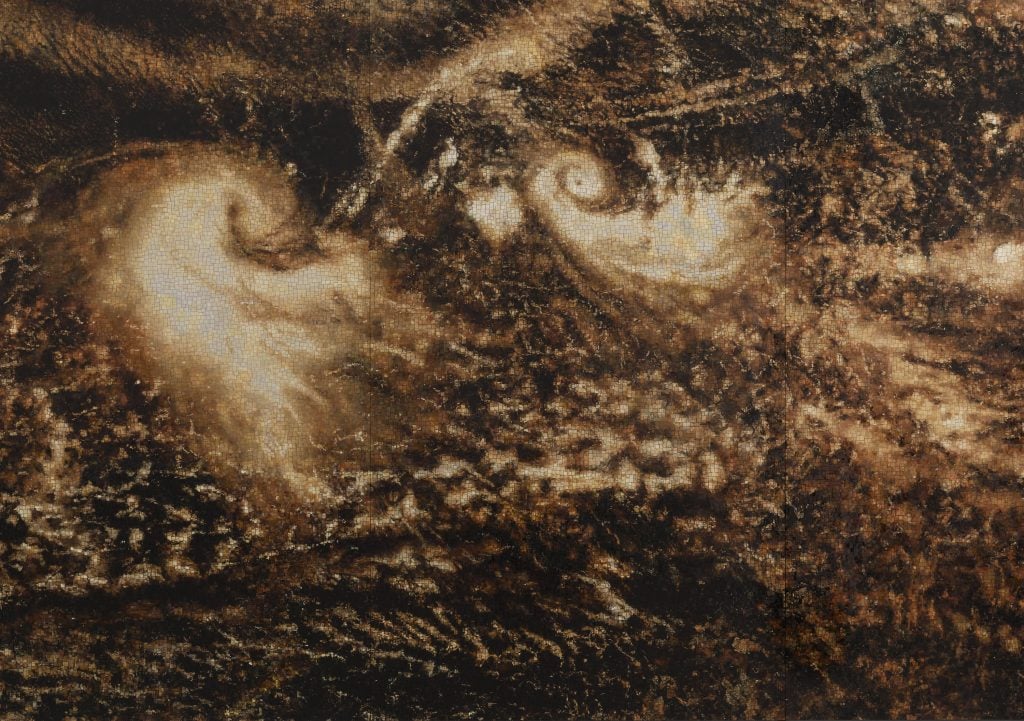
Teresita Fernández, Caribbean Cosmos(Earth) (Detail) (2023). Glazed ceramic. Courtesy the artist and Lehmann Maupin, New York, Hong Kong, Seoul, and London © Teresita Fernández.
For Fernández, Smithson is just one example of larger art historical tropes that need to be deconstructed. The so-called “land artists” of the mid-20th century learned from ancient Mesoamerican sites, but “there is a lot of omission and erasure” of that vital connection, she points out. In many of the movement’s canonical interventions, “we never have to think about human beings, about whose land it is.”
Besides Smithson, Fernández has drawn comparisons to Light and Space artists like Robert Irwin and James Turrell, as well as conceptual artist Felix Gonzales-Torres. Her sculptures, often massive, but composed of thousands of small elements, are always made of materials closely linked to their conceptual undertones and origins. Philosophically the work has been deeply informed by Chinese and Japanese notions of landscapes as dynamic environments, made up of many interdependent elements.
Born in 1968 into a family of Cuban immigrants to Miami, and now with an illustrious career under her belt, Fernández is equally thoughtful about how she frames her personal history and cultural identity. Appointed by Barack Obama in 2011 as the first Latina on the U.S. Commission of Fine Arts, she has helped support the careers of other Latinx artists and curators, launching the U.S. Latinx Arts Futures Symposium in 2016 in partnership with the Ford Foundation. Yet she has also treaded carefully around the pigeonhole that comes with identity politics.
In a 2014 interview with The Brooklyn Rail she said: “I’ve worked really hard at representing myself with the ideas that are important to me, and for me it’s really about the work, not about the personal story. And so, it’s not fun when those rather complex, layered, and subtle references are replaced with someone’s exoticized fantasy about who you’re supposed to be or some thin version of ‘memory’—usually someone else’s—layered over my identity or my art.”
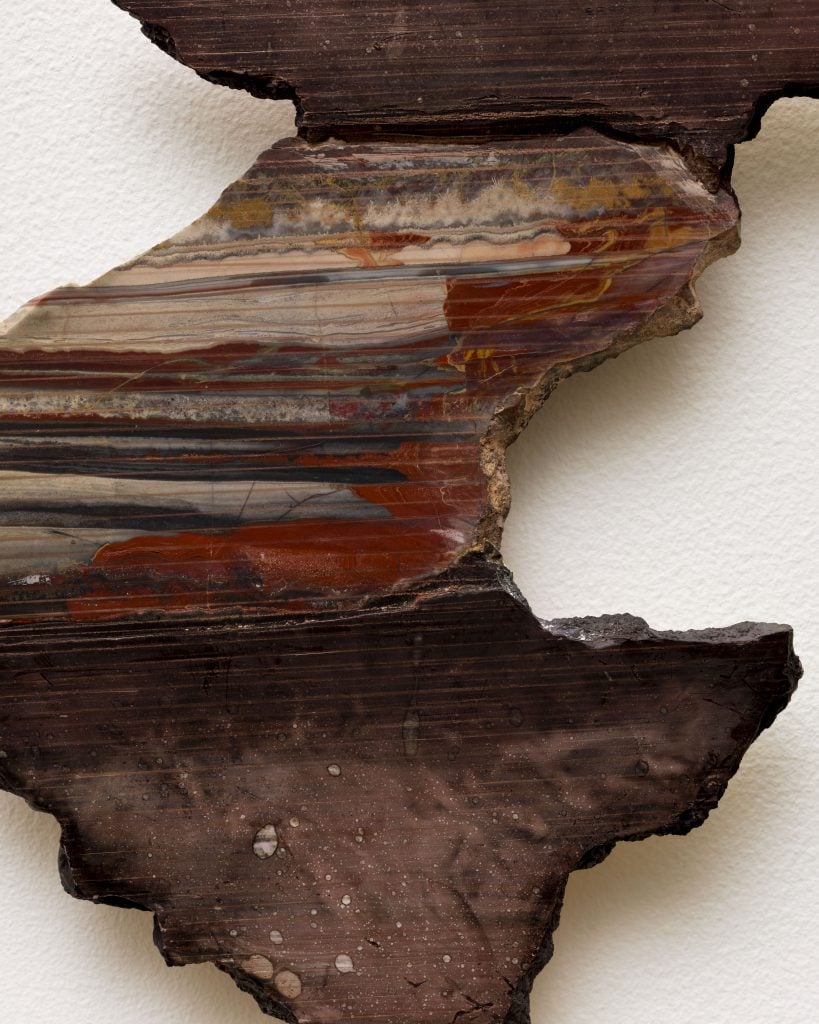
Teresita Fernández, Bardo 3 (Detail) 2024. Stone, plaster, and mixed media. Courtesy the artist and Lehmann Maupin, New York, Seoul, and London.
In terms of her childhood creative interests, she said in our interview there were few singular moments she can pinpoint as the definitive budding of her life as an artist. Still, she spent a lot of time in her family’s dressmaking workshop and “had a very rich inner life,” she said. “I had a huge library in my home. I also lived in a physically very stunning landscape, where we learned by being in the world, outside.”
Becoming an artist was more about consciousness itself. “Even as a small child I was very aware of my own awareness. That’s maybe the most important quality to have for what we define as an artist,” she said. “A sense of oneself as having a way, a method, to give shape to what one was paying attention to, was a very empowering realization.”
In college at Virginia Commonwealth University it became clearer to Fernández that she was grappling with something called art, and she was quickly noticed at the school’s M.F.A. program as a star pupil for her radical architectural installations. A 1998 residency in Japan after graduate school became a critical step in her practice, where she learned of the Japanese gardening technique shakkei, which designs the garden to capture an existing view of a more distant landscape. She soon began making outdoor works with the land.
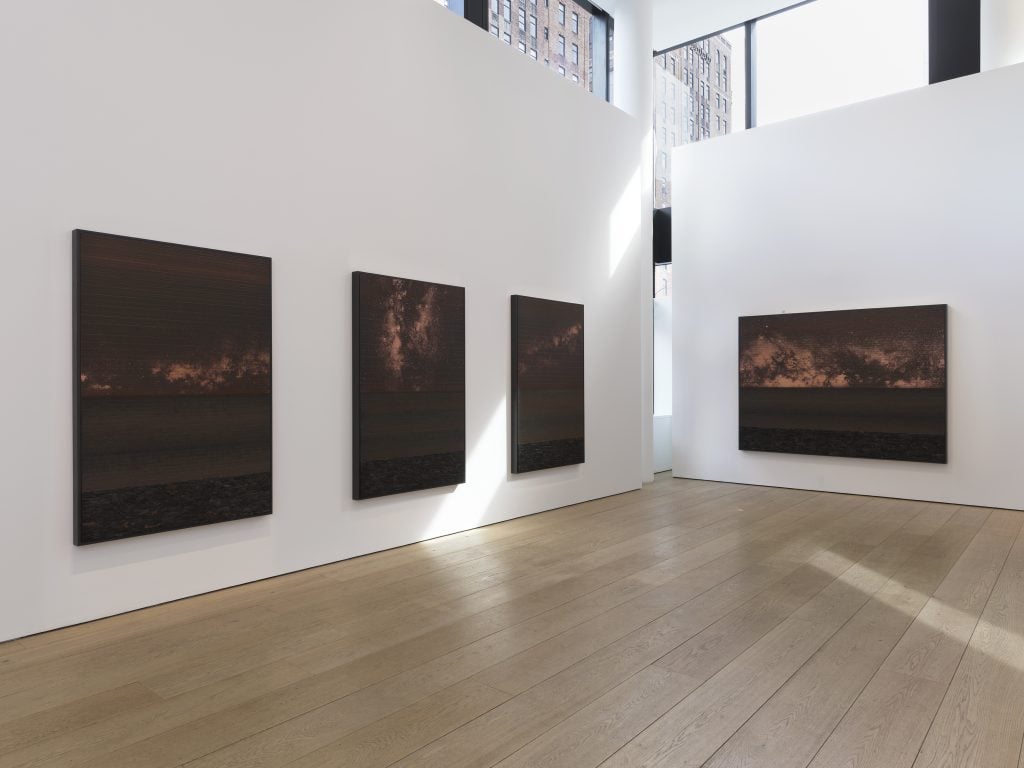
Installation view of “Teresita Fernández: Soil Horizon” at Lehmann Maupin in New York. Courtesy the artist and Lehmann Maupin, New York, Seoul, and London.
Fernández incorporates a wide range of “elemental” and natural materials in her pieces, driven by intense research, so the medium itself is steeped in meaning. “The public doesn’t know how much research goes into the work,” said the artist’s longtime gallerist, Rachel Lehmann. Her conceptual approach to materials continues to evolve as “she’s been pushing it and perfecting it in many ways,” Lehmann said. She cited recent pieces referencing the artist’s personal experiences and places of origin, as well as death and the life cycle, that show “there is beauty in aging, there is beauty in going to the next step.”
In her past works, Fernández has strung up and dyed silk to look like fire, experimented with reflective surfaces from fiberglass to glazed ceramics to mirror our own image back at us, and arranged charcoal and volcanic rocks into shadows, nightscapes, and fictional maps (as all maps inherently are, she notes). But before she transforms materials through the alchemy of art-making, she always tries to tune into their raw, inherent character. “I have to have a dialogue with them,” she said, “because it is a humbling experience to understand what something already is before I try to make it into something else.”
Teresita Fernández: Soil Horizon is on view at Lehmann Maupin in New York until June 1, 2024. Teresita Fernández / Robert Smithson will be at SITE Santa Fe from July 5 until October 28, 2024.